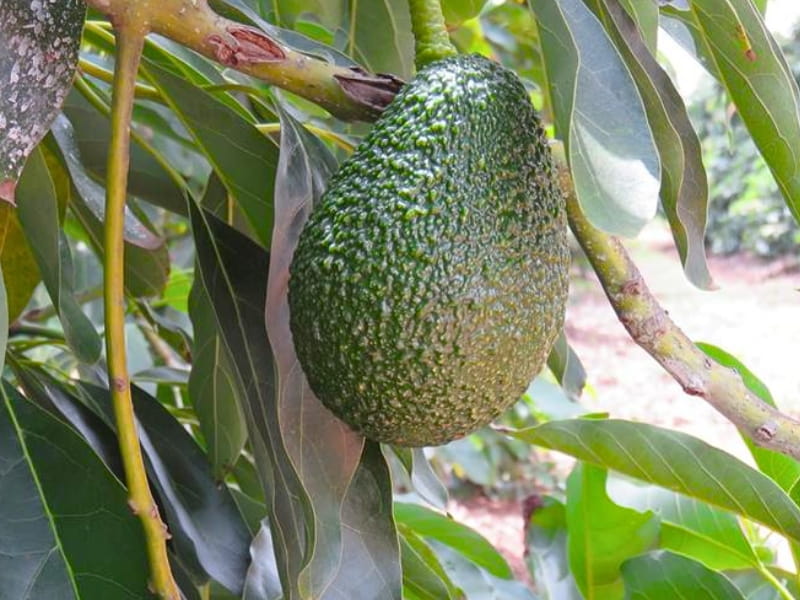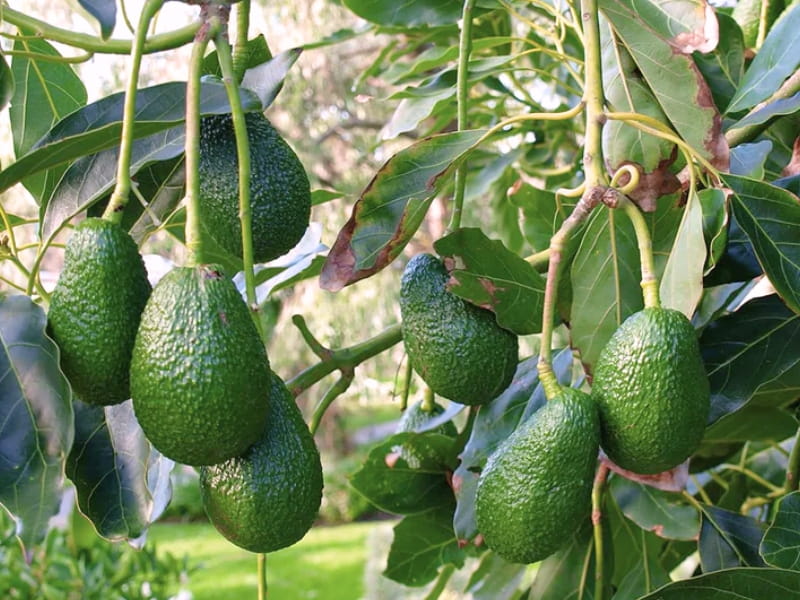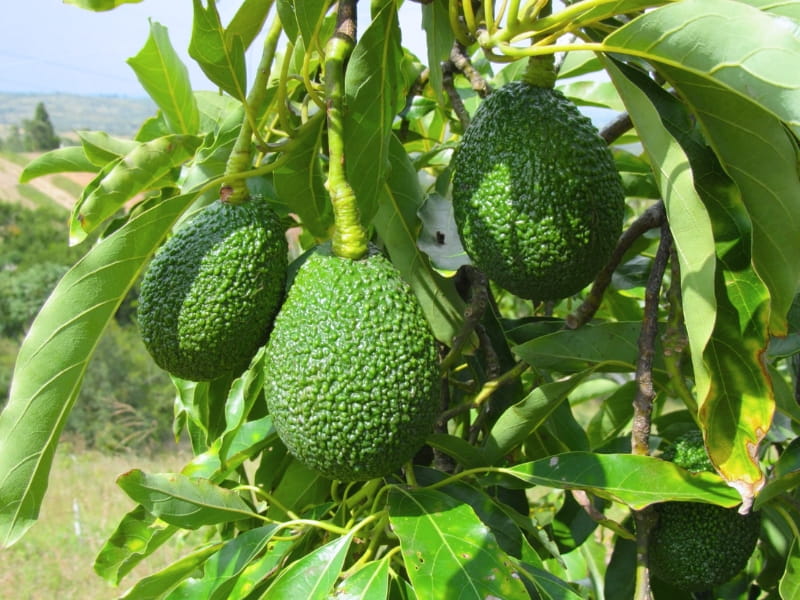Hass Avocado Tree, also commonly known as ‘Haas’ avocado, or scientifically as Persea americana ‘Hass’, is a cultivar cherished for its creamy, rich-flavored fruit and relatively compact growth habit. This makes it a favorite among home gardeners and commercial growers alike, with its fruit dominating the global avocado market. Related terms often searched include avocado tree care, growing avocados, and avocado tree varieties.
At Gardencenterpoint.com, we understand the desire to cultivate your own fresh, delicious avocados. This comprehensive guide provides the solutions and all the essential information, step-by-step instructions, and expert advice you need to successfully grow and care for your Hass Avocado tree, regardless of your gardening experience, from planting to harvesting, and even addressing common problems. We also offer the transactional needs of a buyer, linking to reputable sellers.

Hass Avocado Tree Overview
The Hass avocado is a cultivar of avocado that originated in California. It was discovered by Rudolph Hass, a mail carrier and amateur horticulturist, in the 1920s. He patented the variety in 1935. The original Hass mother tree stood for many years in La Habra Heights, California, before succumbing to root rot in 2002. All Hass avocado trees are descended from this single tree, propagated through grafting.
| Common name | Hass Avocado, Haas Avocado |
| Botanical name | Persea americana ‘Hass’ |
| Family | Lauraceae |
| Genus | Persea |
| Species | americana |
| Origin | California, USA |
| Native | (Cultivar, originated in California) |
| Life cycle | Perennial |
| Plant type | Tree |
| Hardiness zone | 9, 10, 11 (USDA) |
| Sunlight | Full Sun (6-8 hours minimum) |
| Maintenance | Moderate |
| Water | Moderate (well-drained, avoid overwatering) |
| Drainage | Well-Drained (essential) |
| Spacing | 15-20 ft. |
| Flowering period | Late Winter to Spring |
| Fruiting Period | Late Winter to Spring (can vary) |
| Height | 20-30 ft. (potentially taller in ideal conditions) |
| Growth rate | Moderate to Fast (when young) |
| Flower color | Greenish-yellow |
| Fruit Color | Green (unripe), Purplish-black (ripe) |
| Stem color | Green (young), Brown (mature) |
| Flower benefit | Attracts Pollinators (bees) |
| Fruit Benefit | Edible, Nutritious, High in Healthy Fats |
| Garden style | Subtropical, Orchard, Edible Landscape |
| Uses | Fruit Production, Shade Tree, Ornamental |
| Soil pH | 6.0-7.0 (Slightly Acidic to Neutral) |
| Soil Type | Sandy Loam, Decomposed Granite |
| Pollination | Partially Self-pollinating (Type A flower; benefits from cross-pollination) |
| Propagation | Grafting (primarily) |
| Pest Susceptibility | Moderate (Avocado Lace Bug, Mites, Root Rot) |
| Disease Susceptibility | Moderate (Root Rot, Anthracnose) |
| Drought Tolerance | Moderate (once established) |
| Frost Tolerance | Low (especially when young) |
| Deer Resistance | Moderate. |
| Leaf Type | Evergreen. |
| Leaf Shape | Lanceolate. |
| Leaf Color | Green |
The popularity of the Hass avocado is due to several key characteristics:
- Exceptional Flavor and Texture: The fruit has a rich, nutty flavor and a creamy, smooth texture, making it ideal for guacamole, salads, sandwiches, and many other dishes.
- High Oil Content: Hass avocados have a high oil content (around 18-20%), contributing to their smooth texture and rich flavor.
- Long Shelf Life: Compared to other avocado varieties, Hass avocados have a relatively long shelf life, making them commercially viable.
- Consistent Production: Hass trees are known for their consistent and heavy fruit production.
- Easy to Peel and Pit: The skin of a ripe Hass avocado is easy to peel, and the seed is relatively small compared to the amount of flesh.
- Skin Changes color The skin of this fruit change from green (unripe) to purplish-black (ripe).
Choosing the Right Location and Soil for Your Hass Avocado Tree
Selecting the right location is crucial for the long-term health and productivity of your Hass avocado tree. Here’s what to consider:
- Sunlight: Avocado trees thrive in full sun, requiring at least 6-8 hours of direct sunlight per day. More sunlight generally leads to better fruit production. In extremely hot climates, some afternoon shade might be beneficial to prevent sunburn on the leaves and fruit.
- Climate: Hass avocados are best suited for warm, subtropical climates. They are sensitive to frost and freezing temperatures. The ideal temperature range for Hass avocado trees is between 65°F and 80°F (18°C and 27°C). While mature trees can tolerate brief periods of temperatures down to around 30°F (-1°C), young trees are much more vulnerable and should be protected from frost. The USDA Plant Hardiness Zones 9-11 are generally suitable.
- Soil: Well-drained soil is absolutely essential. Avocado trees are highly susceptible to root rot, which is caused by waterlogged soil. The ideal soil is a loose, sandy loam or decomposed granite mix. Avoid heavy clay soils that retain too much water. If you have heavy clay soil, you can amend it with organic matter like compost, perlite, or vermiculite to improve drainage. Alternatively, consider planting your avocado tree in a raised bed or mound.
- Soil pH: Avocado trees prefer slightly acidic to neutral soil with a pH between 6.0 and 7.0. A soil test can determine your soil’s pH. If the pH is too high (alkaline), you can amend the soil with sulfur or other acidifying agents. If the pH is too low (acidic), you can add lime.
- Space: While Hass avocado trees are relatively compact compared to some other varieties, they still need adequate space to grow. Mature trees can reach heights of 20-30 feet and widths of 15-20 feet. Consider the mature size of the tree when choosing a planting location, ensuring it’s not too close to buildings, power lines, or other trees.
- Wind Protection: Strong winds can damage avocado trees, especially young ones. Choose a location that is sheltered from strong prevailing winds. If necessary, you can create a windbreak using a fence, hedge, or other structure.
- Drainage Test: Before Planting, you should test your soil drainage, dig a hole 1 foot deep and 1 foot wide. Fill the hole with water. If the water drains within 2-3 hours, the drainage is good. If it takes longer than 6 hours, the drainage is poor and you’ll need to amend the soil or choose a different location.
Planting Your Hass Avocado Tree: A Step-by-Step Guide
Planting your Hass avocado tree correctly is the foundation for its future health. Here’s a detailed guide:
- Timing: The best time to plant an avocado tree is in the spring, after the danger of frost has passed. This gives the tree ample time to establish itself before the cooler temperatures of fall and winter.
- Choosing a Tree: Select a healthy, vigorous tree from a reputable nursery. Look for a tree with strong, green leaves and no signs of disease or pests. The tree should be well-branched and have a good root system. Gardencenterpoint.com can help you find nurseries near you with high-quality Hass avocado trees.
- Preparing the Hole: Dig a hole that is twice as wide as the root ball and just as deep. This allows the roots to spread easily. Gently loosen the soil at the bottom of the hole to encourage root penetration.
- Removing the Tree from the Container: Carefully remove the tree from its container, being careful not to damage the roots. If the roots are tightly circling the bottom of the pot (root-bound), gently loosen them with your fingers or make a few vertical cuts along the sides of the root ball.
- Planting the Tree: Place the tree in the hole so that the top of the root ball is level with or slightly above the surrounding soil. This is crucial to prevent root rot. Backfill the hole with the native soil, gently firming it around the roots. Avoid adding amendments like compost or fertilizer to the planting hole, as this can create a “pot” effect and hinder root development into the surrounding soil.
- Watering: Water the tree deeply and thoroughly immediately after planting. This helps settle the soil and eliminate air pockets around the roots.
- Mulching: Apply a thick layer (3-4 inches) of organic mulch, such as wood chips or shredded bark, around the base of the tree. Keep the mulch several inches away from the trunk to prevent rot. Mulch helps conserve moisture, suppress weeds, and regulate soil temperature.
- Staking (Optional): Young trees may benefit from staking, especially in windy areas. Use two stakes placed on opposite sides of the tree and tie them loosely to the trunk with soft material. Remove the stakes after a year or two, once the tree is well-established.
Watering Your Hass Avocado Tree: Finding the Right Balance
Proper watering is critical for avocado trees, especially during their first few years. Overwatering and underwatering can both lead to serious problems.
- Young Trees (First 1-2 Years): Young trees need frequent watering to establish their root systems. Water deeply 2-3 times per week, especially during dry periods. The soil should be moist but not soggy. A good rule of thumb is to water when the top 2-3 inches of soil are dry.
- Mature Trees (3+ Years): Mature trees are more drought-tolerant but still need regular watering, especially during fruit development. Water deeply and less frequently than young trees, allowing the soil to dry out slightly between waterings. The frequency will depend on your climate, soil type, and rainfall. During hot, dry periods, you may need to water once a week or even more often.
- Signs of Overwatering: Yellowing leaves, leaf drop, wilting, and soft, mushy roots are signs of overwatering. Reduce watering frequency and improve drainage if you observe these symptoms.
- Signs of Underwatering: Wilting leaves, dry, brittle leaves, leaf drop, and slow growth are signs of underwatering. Increase watering frequency if you observe these symptoms.
- Irrigation Methods: Drip irrigation or soaker hoses are the most efficient methods for watering avocado trees. They deliver water directly to the roots, minimizing water waste and reducing the risk of fungal diseases. Avoid overhead sprinklers, which can wet the foliage and increase the risk of disease.
- Seasonal Changes: Adjust the water ammount according to the season, in winter, you should water your tree less often.
Fertilizing Your Hass Avocado Tree: Providing Essential Nutrients
Avocado trees are heavy feeders and require regular fertilization to thrive and produce abundant fruit.
- Fertilizer Type: Use a balanced fertilizer formulated for citrus or avocado trees. These fertilizers typically have a higher nitrogen content, which is important for foliage growth, as well as potassium and phosphorus for flowering and fruit development. Look for a fertilizer with micronutrients like zinc, iron, manganese, and boron, which are also essential for avocado trees.
- Fertilizing Schedule:
- Year 1: Apply fertilizer every 2-3 months, starting in the spring after planting. Use a small amount of fertilizer, following the package instructions carefully.
- Year 2: Apply fertilizer 3-4 times per year, increasing the amount slightly as the tree grows.
- Year 3 and Beyond: Apply fertilizer 3-4 times per year, using the recommended amount for the tree’s size.
- Application Method: Spread the fertilizer evenly around the drip line of the tree (the area under the outer edge of the canopy). Avoid applying fertilizer directly to the trunk. Water the fertilizer in thoroughly after application.
- Soil Testing: A soil test can help you determine if your soil is deficient in any specific nutrients. This can help you tailor your fertilization program to meet the specific needs of your tree.
- Organic Options: If you prefer organic gardening, you can use compost, compost tea, fish emulsion, or other organic fertilizers to feed your avocado tree. These materials release nutrients slowly, providing a steady supply to the tree.
- Avoid over-fertilization: Over-fertilization cause salt buildup in the soil, which can damage the roots.

Pruning Your Hass Avocado Tree: Shaping and Maintaining
Pruning is important for maintaining the health, shape, and productivity of your Hass avocado tree.
- Timing: The best time to prune avocado trees is in late winter or early spring, before new growth begins.
- Goals of Pruning:
- Remove Dead, Damaged, or Diseased Wood: This helps prevent the spread of disease and improves air circulation.
- Maintain Shape and Size: Prune to maintain a desired shape and size, preventing the tree from becoming too large or overgrown.
- Encourage Fruit Production: Pruning can help stimulate fruit production by opening up the canopy to sunlight and improving air circulation.
- Thin Out Dense Growth: Remove some branches to allow more light to penetrate the interior of the tree.
- Pruning Techniques:
- Heading Cuts: Shorten branches to encourage lateral growth and a bushier shape.
- Thinning Cuts: Remove entire branches to open up the canopy and improve air circulation.
- Avoid Severe Pruning: Avocado trees do not tolerate heavy pruning well. Avoid removing more than one-third of the tree’s canopy in a single year.
- Tools: Use sharp, clean pruning tools to make clean cuts that heal quickly. Use loppers for larger branches and hand pruners for smaller branches.
Pest and Disease Management for Hass Avocado Trees
Avocado trees can be susceptible to various pests and diseases. Regular monitoring and preventative measures are key to keeping your tree healthy.
- Common Pests:
- Avocado Lace Bug: These small insects feed on the leaves, causing stippling and discoloration.
- Avocado Brown Mite: These tiny mites feed on the leaves, causing bronzing and leaf drop.
- Persea Mite: Similar to brown mites, they cause damage to leaves.
- Thrips: These insects can damage flowers and young fruit.
- Scales: These insects suck sap from the leaves and stems.
- Caterpillars: Some caterpillars can feed on avocado leaves.
- Common Diseases:
- Avocado Root Rot (Phytophthora cinnamomi): This is the most serious disease of avocado trees. It is caused by a soilborne fungus that thrives in wet, poorly drained soils. Symptoms include yellowing leaves, leaf drop, wilting, and dieback. Prevention is key: plant in well-drained soil, avoid overwatering, and use disease-resistant rootstocks.
- Anthracnose: This fungal disease causes dark, sunken lesions on fruit, leaves, and stems.
- Scab: This fungal disease causes raised, corky spots on fruit and leaves.
- Sunblotch: This viral disease causes yellow streaks and blotches on leaves and fruit. There is no cure for sunblotch; infected trees should be removed.
- Management Strategies:
- Cultural Practices: Proper watering, fertilization, and pruning can help keep trees healthy and less susceptible to pests and diseases.
- Biological Control: Encourage beneficial insects, such as lacewings and ladybugs, that prey on avocado pests.
- Organic Pesticides: Use insecticidal soap, neem oil, or other organic pesticides to control pests if necessary.
- Fungicides: Fungicides can be used to prevent or control fungal diseases. Copper-based fungicides are often effective.
- Monitoring: Regularly inspect your tree for signs of pests and diseases. Early detection is crucial for effective management.
Harvesting Your Hass Avocados
Hass avocados don’t ripen on the tree. They mature on the tree but only soften after they are picked. This is a unique characteristic of avocados.
- Maturity Indicators: Determining when Hass avocados are mature can be tricky. Here are some indicators:
- Size and Shape: The fruit should be full-sized and have a characteristic oval or pear shape.
- Skin Color: The skin color changes from green to a dark purplish-black as the fruit matures. However, skin color alone is not a reliable indicator of maturity, as it can be influenced by environmental factors.
- Stem Test: Gently twist the stem of the fruit. If it comes off easily, the fruit is likely mature.
- Time of Year: Hass avocados typically mature in the late winter to spring, but the exact timing can vary depending on your climate and the tree’s growing conditions.
- Harvesting Technique: To harvest avocados, use pruning shears or a sharp knife to cut the stem close to the fruit. Avoid pulling the fruit from the tree, as this can damage the stem and reduce its shelf life.
- Ripening: After harvesting, allow the avocados to ripen at room temperature. This typically takes 3-7 days, depending on the maturity of the fruit and the ambient temperature. To speed up ripening, place the avocados in a paper bag with a banana or apple. These fruits release ethylene gas, which promotes ripening.
- Storing Ripe Avocados: Once ripe, avocados can be stored in the refrigerator for several days to slow down the ripening process.
Pollination of Hass Avocado Trees Avocado trees have a unique flowering behavior that affects pollination and fruit set. Avocado flowers are classified as “A-type” or “B-type” based on their flowering pattern.
- A-Type Flowers (Hass): A-type flowers, like those of the Hass variety, open as female in the morning of the first day, receptive to pollen. They then close in the afternoon and reopen as male the following afternoon, shedding pollen.
- B-Type Flowers: B-type flowers open as female in the afternoon of the first day and reopen as male the following morning.
- Cross-Pollination: While avocado trees can self-pollinate to some extent, cross-pollination with a different variety (A-type with B-type) generally results in better fruit set and larger fruit.
- Pollinators: Bees are the primary pollinators of avocado flowers.
- Planting for Cross-Pollination: To maximize fruit production, it’s recommended to plant a Hass avocado tree (A-type) near a B-type avocado variety, such as ‘Fuerte’, ‘Zutano’, or ‘Bacon’. The closer the trees are, the better the chances of cross-pollination. However, even without a B-type pollinator, Hass trees can still produce fruit, especially in areas with high bee activity.

Propagation of Hass Avocado Trees
Hass avocado trees are typically propagated through grafting. Grafting involves joining a scion (a cutting from a Hass avocado tree) onto a rootstock (a seedling or cutting from a different avocado variety).
- Why Grafting?: Grafting ensures that the new tree will be true to type, producing fruit with the same characteristics as the parent tree. Avocado trees grown from seed do not always produce fruit that is identical to the parent tree.
- Rootstocks: Rootstocks are chosen for their disease resistance, vigor, and compatibility with the scion. Common rootstocks for Hass avocado trees include ‘Duke 7’, ‘Toro Canyon’, and ‘Dusa’.
- Grafting Techniques: Several grafting techniques can be used, including cleft grafting, whip grafting, and side-veneer grafting.
- Timing: Grafting is typically done in the spring or fall.
- Aftercare: After grafting, it’s important to protect the graft union from drying out and to provide the newly grafted tree with proper care, including watering and fertilization.
- Professional Propagation: Grafting avocado trees requires skill and experience. It’s often best left to professional nurseries.
Nutritional Value and Health Benefits of Hass Avocados
Hass avocados are a nutrient-rich fruit packed with vitamins, minerals, and healthy fats.
- Healthy Fats: Avocados are high in monounsaturated fats, which are considered “good” fats that can help lower bad cholesterol levels and reduce the risk of heart disease.
- Vitamins and Minerals: Avocados are a good source of vitamins K, C, B5, B6, and E, as well as folate, potassium, and magnesium.
- Fiber: Avocados are a good source of dietary fiber, which is important for digestive health.
- Antioxidants: Avocados contain antioxidants, such as lutein and zeaxanthin, which are beneficial for eye health.
- Potential Health Benefits: Studies have shown that avocados may have several health benefits, including:
- Lowering cholesterol levels
- Reducing the risk of heart disease
- Improving blood sugar control
- Promoting weight loss
- Protecting against certain types of cancer
- Improving eye health
- Supporting healthy skin and hair
| Nutrient | Amount per 100g | % Daily Value |
| Calories | 160 | 8% |
| Total Fat | 15g | 19% |
| Saturated Fat | 2.1g | 11% |
| Monounsaturated Fat | 10g | |
| Polyunsaturated Fat | 1.8g | |
| Cholesterol | 0mg | 0% |
| Sodium | 7mg | 0% |
| Total Carbohydrate | 9g | 3% |
| Dietary Fiber | 7g | 25% |
| Sugars | 0.7g | |
| Protein | 2g | 4% |
| Vitamin K | 21mcg | 18% |
| Vitamin C | 10mg | 11% |
| Vitamin B5 | 1.4mg | 28% |
| Vitamin B6 | 0.3mg | 18% |
| Vitamin E | 2.1mg | 14% |
| Folate | 81mcg | 20% |
| Potassium | 485mg | 10% |
| Magnesium | 29mg | 7% |
Source: USDA FoodData Central

Leave a Reply